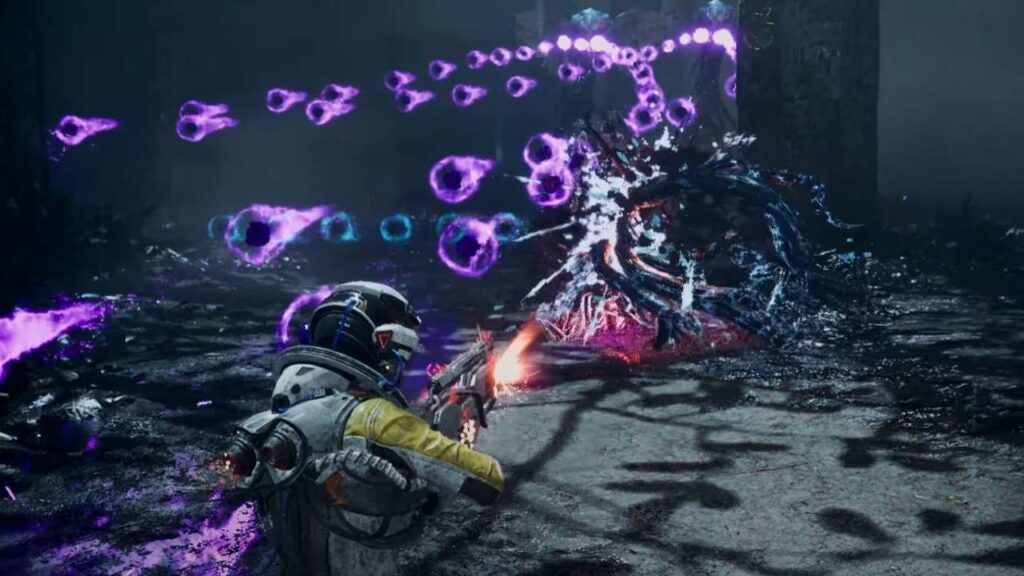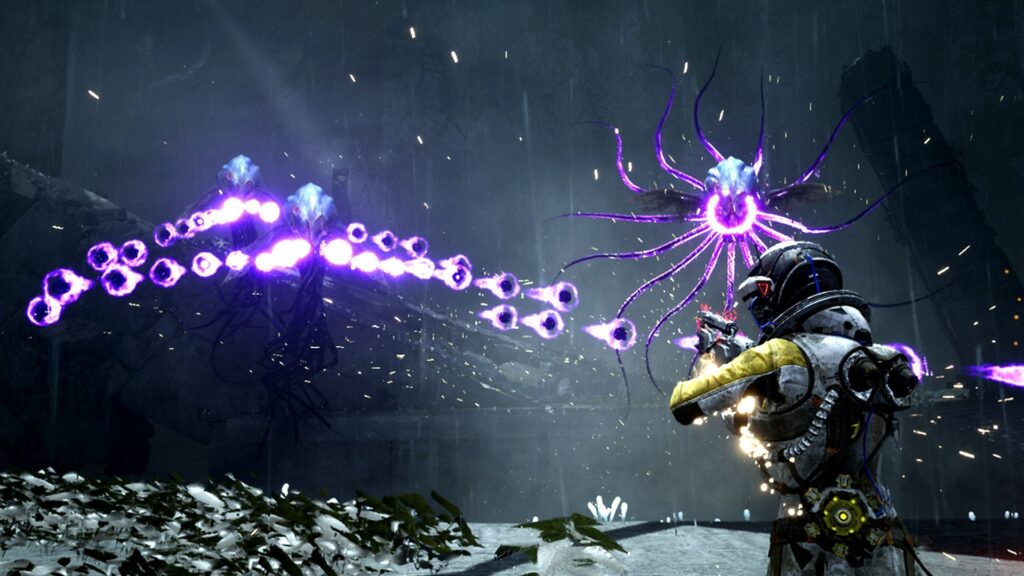Title – Returnal
Platforms – PS5 and PC
Release Date – April 30th, 2021 (PS5) and February 17th (PC)
Developer – Housemarque
Publisher – Sony Interactive Entertainment
MSRP – $69.99
ESRB – T for Teen
Disclaimer – This product is being reviewed on the PlayStation 5. A review copy was provided by 110 Industries for the purpose of this review. This review may also contain spoilers for certain gameplay and story elements. Watch at your own risk, you have been warned. Gaming Instincts is an Amazon Affiliate and does gain financial benefits if you choose to purchase this product on this page.
Brightly colored projectiles bombard the player’s character, Selene, leaving them terrified of failure. They rush to avoid the deadly attacks, shooting bullets at the hideous boss floundering across the arena. Their hands are sweaty and their heart is fast. Suddenly, a purple ball hits their character and Selene falls to the ground. She stands up outside a crashed ship, Returnal’s starting point, ready to try again. A smooth and responsive gameplay environment entices another playthrough even when frustration is boiling.
Every Returnal player faces an anxiety-inducing experience similar to this. The PlayStation 5 exclusive is a difficult, frustrating game but it’s also fun, addictive, and alluring. Every death puts Selene at the beginning, but it’s hard to put the controller down. We learn from our mistakes through Returnal and we keep trying despite our failures. Roguelikes rarely receive Triple-A support, but Sony gave Housemarque and Returnal a chance. Thanks to the eccentric move, Sony First Party Studios has a unique, smartly designed game that taps into Housemarque’s greatest strengths.
Rewarding Repetition – (Gameplay)
Returnal opens in the black vacuum of space with the conservative music creating an eerie and enigmatic atmosphere. The ship is dodging asteroids when its pilot, a blond woman in an astronaut suit, glances at a red signal that reads, “approach forbidden.” As a quick aside: it’s refreshing to see a playable older woman in what is still a highly sexualized medium. As Selene approaches a planet’s atmosphere, the ship starts to break down until it crashes on the mysterious planet. After a black screen, she stands up outside the crashed ship initiating the nightmarish journey of Returnal.
As Selene explores the planet she’s shocked to find a dead version of herself and realizes she is in a seemingly unbreakable loop. A procedurally generated planet with ravenous creatures serves as the backbone of Returnal’s gameplay, a strenuous experience where progress rarely transfers after death.
After each death, Selene encourages herself and the player alike to keep trying, but that’s not our main motivation – it’s the tight gameplay loop. At its most basic level, barring some impressive upgrades, combat involves a combination of jumping, dashing, and shooting. All of these moves are responsive to the point where death never feels like the fault of the game, but of the player. Combat is quick and exhilarating, amplified by the pinpoint transition between button push and character action. Selene’s sprint is incredibly fast and doesn’t suffer from a cooldown effect, emphasizing brevity and diminishing static gameplay.
The doors separating each section of a run surprisingly illustrate the quick nature of the game. They open and close in an instant never halting Selene’s swift movements. The dash is just as quick, serving as Selene’s primary strategy for avoiding damage. For instance, five Kerberonyx could fire lines of blue spheres from every direction causing Selene to jump over them. A hideous Titanops, a huge creature with sinuous tentacles jumps at the protagonist right after avoiding the deadly hit. Selene barely escapes death with a well-timed dodge.
Selene must do more than dodge. The player also returns fire with the numerous weapons they find in procedurally generated areas. Although the weapons work differently, players will surely find a favorite and return to it in subsequent runs. One great quality of the Hollowseeker, for instance, is its rate of fire and how long it lasts before recharge. In contrast, the Thermogenic Launcher emits one explosive laser at a time. It’s rare for a weapon to miss its intended target, owing to its tight, refined control systems.
In addition to their standard firing mode, each weapon has an alternative fire function, triggered by the Dualsense’s adaptive triggers. Depending on the weapon and add-ons a half-press launches standard fire and a full press fires an array of lasers. Alt-fire is essential for survival and whittling down the enemy’s health. Pushing the trigger fully is a satisfying feeling that fits with its in-game response. Suffice it to say, Returnal’s gunplay and traversal are faultless and that may be due to Housemarque’s experience with arcade-style games.
PlayStation fans may recognize the side-scrolling, shoot ’em’ up Resogun, or the twin-stick shooter, Nex Machina. They are small-scale games reminiscent of difficult bullet hell titles from the arcade era. This backbone clearly influenced Returnal, which is evidenced in the bullet-ridden attacks from the various antagonistic creatures. The Archonact is an annoying foe that unleashes a spiral of spheres at Selene while its little brother, the Aethorate shoots the same spheres but they’re formatted in a square.
When several enemies all attack in a myriad of shapes and sizes the player must dodge them like a 3D version of Galaga. Astonishingly, Housemarque could combine arcade-style combat and rogue-like progression into a refined and satisfying Triple-A experience. Even with this masterfully crafted gameplay, Returnal must have some sense of progression from death to death. There is no point in even the best gameplay if players don’t feel like they’re accomplishing anything.
Returnal entices players with a steady sense of progression from a skill, upgrade, and story perspective. When first entering the Overgrown Ruins, the litany of enemies can feel overwhelming and the map layouts can be confusing. Players should expect to die a couple of times, but each death grants wisdom. They’ll understand enemy move sets and memorize area layout, eventually passing through the ruins without breaking a sweat.
Each new biome has a similar learning curve, but Returnal also grants permanent gadgets upon defeating bosses and completing objectives. The first of which is a saber – strikingly similar to a lightsaber that unbars melee functionality and opens new paths. Suddenly, the Overgrown Ruins are new and refreshing even though Selene has explored them several times. The grappling hook works in a similar Metroidvania fashion, unlocking new paths with new rewards. This new sense of discovery drives the player to keep going, especially because exploration leads to great rewards. Selene can find artifacts that grant her a second life or consumables that limit alt-fire cooldown.
Other pick-ups include parasites that attach to Selene’s suit, granting her positive and negative attributes such as enabling fall damage while increasing melee strength. For a quick note of advice, these nasty critters can provide powerful upgrades so don’t be scared of them. The quality of buffs largely affects a player’s likelihood of success, making exploration just as satisfying as combat. With that in mind, Selene must enter a boss battle with impressive stats for any hope of survival. The trail will be arduous but bosses are key to unlocking biomes and story progression.
It should be clear by now that boss fights are chaotic and challenging. Take the Phrike fight, for example. The three-armed creature emerges from a floor of fog, ready to fight. He rains spirals of orange spheres from the sky while shooting a steady stream of purple projectiles like a machine gun. He’ll also dive into the fog and dash around the arena, unseen. Just like every other boss, Phrike has three stages with a new set of attacks for each one. The sweaty palms and held breaths are worth all the stress when Phrike finally goes down. It’s a thrilling experience that cements Returnal as more than an action-adventure. Instead, it may be best described as a horror game.
The piece-milled storyline substantiates the horror vibes thanks to its primary delivery device. Selene will randomly run across an out-of-place house and risk venturing inside. After opening the creaking door, the camera shifts to the first person as she explores the lifeless house. An astronaut peeks through the window or rings the doorbell with a striking and spontaneous appearance. The spine-tingling explorations add more pieces to the Returnal puzzle and eventually Selene’s origins fall into place. Without spoilers, the storyline throws some satisfying curveballs for both its delivery and narrative.
Prolonged Sessions – (Final Verdict)
Returnal is a unique experience that fires from all cylinders. The combat is tight and responsive. The progression system keeps the player intrigued and the story is delivered in a satisfying way. The one negative is its lack of save points, which was intentionally designed to avoid save scumming. This is a difficult element for Roguelikes where much of the intensity comes from death, but at the same time, single runs can take 5 hours at least. There has to be a compromise, but until then, Housemarque’s achievements can’t be denied. Returnal’s most impressive feat is the tense horror-induced experience that derives from clever, rewarding game design. So use the restroom, run all the errands, and get ready for a long afternoon of heart-pounding gameplay.
Stay tuned to Gaming Instincts via Twitter, YouTube, and Facebook for more gaming news.






